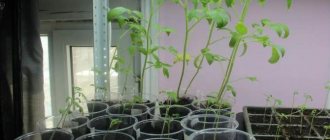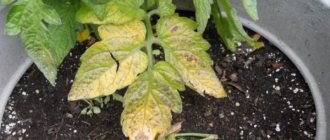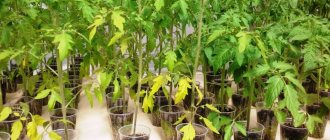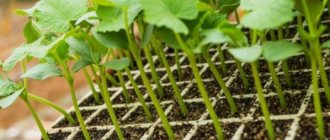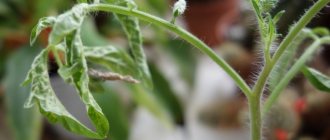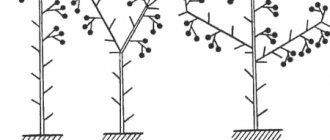- Updated: July 9, 2019
Sometimes it turns out that the seedlings have already grown and it’s time to transplant them into a garden bed or greenhouse, but this cannot be done yet due to weather conditions or for another reason.
Emergency measures must be taken as quickly as possible. Otherwise, the seedlings will begin to stretch out and, due to the limited feeding area, will weaken and then take a long time to take root in a new place and in the future will produce a poor harvest or simply die.
Which seedlings are considered overgrown?
To reap a rich harvest, it is important to grow seedlings correctly. Typically, young plants are completely ready for planting in a permanent place 55 or 60 days after sowing. The height of such specimens is 20 cm, they have elastic leaves and a dense purple stem.
Important! When overgrown, the vitality of the plant decreases. The stem stretches and its thickness decreases. In addition, there is a high probability that the plant will bloom right in the apartment. Transplanting such a plant is difficult. It may die or not produce a harvest.
If the stems of young tomatoes have stretched to a length of 30 cm, overgrowth is considered minor. In this case, no special measures are required. It is enough to simply harden off the seedlings so that they successfully take root in a new place. When the stems are stretched up to 45 cm, they speak of an average degree of overgrowth. To save such plants, special agrotechnical techniques are used. Seedlings larger than 55 cm already have buds. Replanting such specimens is very dangerous.
How to determine if tomato seedlings are overgrown
Many people confuse overgrown tomato seedlings with stretched ones. However, overgrowing and pulling seedlings are different problems, they arise for different reasons, and their solution requires a different approach.
Signs of elongated seedlings are:
- long and thin stem;
- light green tint of shoot;
- large distance between leaves;
- few leaves (4-5);
- long internodes.
Seedlings are pulled out, as a rule, due to a lack of light and violations of the agricultural technology of growing the plant. Such sprouts are weak and their viability is actually in question.
Signs of overgrown seedlings:
- the stems are long, but the color and thickness are the same as those of normal tomatoes;
- the stems have many internodes and, accordingly, leaves;
- the distance between nodes is small.
Overgrown seedlings, unlike stretched ones, are strong and healthy, quite viable. However, due to its large growth, when planting it in a greenhouse or open ground, problems may arise due to the fact that it has already thrown out a brush or falls under its own weight. All of them are solved by planting plants using a special technology or other actions, which will be discussed below.
On the global network you can find information on how to determine the degree of overgrowth of seedlings, and forecasts regarding its survival rate.
- seedlings 30-40 cm high are considered slightly overgrown; the prognosis for their survival rate is favorable;
- if the seedlings have grown to 45-55 cm and have thrown out the brush, then they are considered moderately overgrown. Regarding its survival rate, the forecasts are alarming. It is expected to take root but may not bloom again;
- when the seedlings have stretched more than 55-60 cm, they are called very overgrown, predicting their death.
However, in fact, the size of the seedlings depends on the variety of tomatoes, and after removing the first cluster, the bushes almost always throw out the second (and even the third), so there can be no talk of losing the entire harvest. Believe me: no matter how large your seedlings are, you can root them and make the bushes bear fruit. The main thing is that you will need to transplant it correctly.
Reasons for outgrowing
Strong stretching of tomato seedlings usually occurs due to the inattentive attitude of the gardener. The problem also arises due to improper care:
- early sowing of seeds;
- not enough daylight;
- too much watering;
- non-compliance with temperature conditions;
- abuse of fertilizers.
Sometimes the cause of overgrowth is natural vagaries. The gardener has to wait until the frosts end while the plants continue their active development. At such times, it is important to take steps to slow down the growth of tomatoes.
What drugs can stop the growth of seedlings
Yes, there are such drugs, and almost all of them are hormonal. They are collectively called retordants. They require a very precise dosage, preferably below that specified by the manufacturer. They are used when the seedlings have formed at least 3-4 true leaves: the drugs reduce the height of the internodes. Most often, retortants are used on tomatoes (you need to look at the frequency of treatments allowed by the manufacturer and not overuse); on peppers and eggplants, one treatment is enough. At high concentrations, changes in the roots of plants may occur, leaf burns, and growth arrest may occur (for a longer period than stated). We will not name specific brands; all of them can be easily found by simply searching on the Internet. The seedlings will not become dwarfs, but such chemistry dulls their growth well.
Read about plant growth stimulants here >>>>.
Decrease in growth rate
To prevent overgrowth, it is important to keep containers with planted seeds in a room where the air warms up to a temperature of 16-18 degrees Celsius. In this case, irrigation is carried out once every 7 days.
If for some reason it is not possible to plant seedlings in a greenhouse or an open bed, they resort to agrotechnical methods that slow down growth:
- boxes with seedlings are moved to a cool room;
- increase the interval between irrigations, use less water for irrigation.
If the foliage of the seedlings has turned pale, give nitrogen fertilizing. Additionally, the plant is illuminated so as to increase the duration of daylight hours to 16 hours.
Read also: Tomato seedlings are thin and long, what to do? Many gardeners and gardeners prefer to grow tomato seedlings on their own, without relying on market...
Long-legged seedlings reach for the window
Long legs are good on the podium, but in the case of seedlings this is a clear disadvantage. If your crops point their heads towards the window, they absolutely do not have enough lighting.
Seedlings reach for the light
Immediately get phytolamps or fluorescent lamps and hang them above the racks with seedlings. Keep the lights 5 to 10cm above the plants to encourage them to grow strong and stocky. Without a good light source, phototropism will cause seedlings to reach for light and become weak and thin. Seedlings need at least 12-16 hours of light every day until the beginning of April, then additional light can be left for 8 hours. In May, it is no longer necessary to add additional light to the seedlings; they are taken out into the fresh air during the day and accustomed to the sun's rays.
Strong and high-quality tomato seedlings are impossible without additional lighting
Hardening off plants or transplanting them outside can also help control legginess. Most leggy plants grow stronger when moved outdoors.
How to choose the right phytolamp for supplementary illumination of seedlings?
Pepper seedlings receive sufficient lighting
Options for solving the problem
If it is too late to stop the growth of young seedlings, there is no need to throw away the seedlings. Even overgrown plants can be worked on so as not to lose the harvest. Several methods for restoring such plants have been developed.
Transplanting into a larger container
The easiest way to revive an overgrown plant is to transplant it into a container that is larger in height. Otherwise, the root system of the plant will begin to dry out and it will die. This option is recommended if the number of overgrown specimens is small. The advantage of this method is that it allows you to get an early harvest.
Plant division
Another good method to restore the viability of overgrown seedlings is to divide the seedling into two parts. Place each part in a jar of water and wait for the roots to grow. In this way, instead of one weak plant, 2-3 quite strong specimens are obtained. When the roots have grown sufficiently, the seedlings are placed in the ground. With this method, the harvest will appear a week later.
The seedlings are thin and fall over
Are you sure you didn’t forget to plant the seedlings in individual pots?
Picking snapdragon seedlings
Ideally, there should be only one seedling per container to ensure it grows strong and healthy. When growing in a common tray, thinning is necessary. It involves selecting the strongest plants and removing the weak ones. The easiest way to do this with minimal root damage is to trim the unwanted seedlings back to the soil line with scissors.
Some seedlings grow out of their pots before it is time to transplant them outside. These plants will require larger containers so they can continue to grow at a normal rate. Once the roots fill the container or you find that you need to constantly water the plants, it is time to transplant the seedlings into larger containers.
Picking: technology for thinning and transplanting seedlings of vegetables and flowers
Hardening
For seedlings that have grown slightly, it is useful to harden them before planting. This procedure will strengthen the plants' immunity and help avoid problems during cultivation. For a sensitive root system after hardening, the transition to new living conditions will be less painful.
Hardening takes from 7 to 10 days and consists of meeting the following conditions:
- Hardening begins on a warm, humid day. Such conditions will not harm the plant, but will only benefit it.
- On the first day, the plant is taken outside for 2 hours. Then increase this period by 1 hour every day. After a week, the tomatoes are left outside all daylight hours.
- Trays with seedlings are placed outdoors so that they are not exposed to direct sunlight or exposed to cold winds. Every day the plants are opened briefly if the day is sunny. In cloudy weather, additional shelter is not needed.
Important! Hardening is more effective if the seedlings were grown at home at a temperature of no more than +20 degrees and were not flooded.
How to plant such seedlings in open ground?
Before planting overgrown seedlings, they must be hardened off. This should be done gradually, increasing the time spent in the air every day. The most favorable conditions for hardening will be damp, cloudy weather or evening time. When planting, the bottom two leaves should be cut off and the plant should be placed horizontally in the prepared ditch. Cover with soil up to the outer leaves. Planted plants should be watered abundantly, because the next watering should be done no earlier than in a week.
Everyone knows that it is better to prevent any problem than to solve it later. When growing seedlings, it is quite possible to calculate all the risks in advance and try to minimize them. Creating comfortable conditions for growing seedlings should begin already at the stage of preparing and sowing seeds.
Do you want to always have at hand a convenient lunar calendar, which indicates favorable and unfavorable dates for planting and replanting indoor flowers, watering and fertilizing plants, and treating pests? We present to your attention the application Lunar calendar of indoor plants
, which can be DOWNLOADED completely free of charge in the Play market via LINK.
The lunar calendar for caring for indoor plants contains the exact times of New Moons, Full Moons, the beginning of lunar days and the Moon’s entry into the zodiac signs. Favorable and unfavorable dates are indicated for planting and replanting indoor flowers, watering and fertilizing plants, and treating pests.
Transplanting overgrown seedlings
After hardening, overgrown tomatoes are planted only in well-warmed soil. If the ground is cold, there is a high chance that the plant will die or become infected with a fungal infection. The air temperature should be above +15 degrees. In Russia, the favorable time for planting occurs at the end of April or at the beginning of May, when the final warmth sets in outside.
Read also: Why did tomato seedlings turn lilac? Even experienced gardeners encounter problems when growing tomato seedlings. And one of them is a change in color...
Landing at an angle
This method is the simplest and gives good plant survival. A few days before planting, all leaves are cut off from the bottom of the stem by 2/3 of the length. It is important to do this not immediately before planting, so that the wounds have time to heal and infection does not penetrate into them.
Then they dig a furrow 10 cm long and place the seedling in it so that the root system faces south. The plant is covered with earth, leaving only the top on the surface, and watered abundantly. When it grows, the stem will stretch towards the sun and straighten out.
Deepening
For this method of planting, plants whose length does not exceed 55 cm are suitable. In this case, dig a hole the size of which corresponds to the size of the container in which the seedlings grew. Humus is placed at the bottom of the planting hole and 5 liters of water are poured. The bush is removed from the box and placed in the prepared hole so that its top is 30 cm above the ground level. All the leaves below are torn off. The hole is filled with soil and the tomato is tied to a support.
With this type of planting, which is called vertical, the plant will soon grow a powerful root system in the upper part. In a few days the tomatoes will become strong and produce a good harvest.
Kazarin's dry method
In this case, furrows with a depth of 10 to 15 cm are also made for planting. Then humus is placed in the furrows, thoroughly moistened and spilled with a solution of potassium permanganate. The lower leaves are plucked from the seedlings and placed in prepared furrows in an almost horizontal position. Having covered the plants with soil, they are watered abundantly.
Important! After a single watering, irrigation is no longer carried out throughout the season. This forces the tomatoes, deprived of moisture, to build up a powerful root system in order to reach the water in the soil.
In the first few days, the tops of tomato seedlings lie down, and then begin to grow vertically. After this, they are tied to a support.
Pro Tips: Kazarin Method
Planting seedlings in open ground or in a greenhouse is a stressful situation for the plant, especially for an overgrown one. Kazarin's method involves further aggravating this stress by not watering the plants. That is why it is considered the dry method. The plant is forced, so to speak, to independently look for a source of moisture. Due to this, a powerful root system develops, deeply buried in the depths of the soil.
It is worth paying close attention to this technique if planting is carried out in a greenhouse. Often the bottom of the greenhouse is closed and the plant simply cannot go down to the required depth. How to do it:
- make holes in the ground, maintaining a distance between them of at least 50 centimeters;
- prepare a growth stimulator (ash, droppings or compost, 1 gram of potassium permanganate);
- add a stimulant mixed with soil into each hole;
- tear off all the leaves from the bottom of the plant and divide the stem in half;
- we place the root in the hole, and the stem in a “torn wound” along the bed;
- sprinkle everything with earth, leaving only the top with leaves;
- leave everything in this position and do not water, preferably all summer.
Having studied this method, many gardeners are simply shocked. They argue that such planting, especially in a greenhouse, will not give positive results. But the plant is already on the verge of death, why not try to save it, even with such an insidious method. The tomato takes root very well if the stem is on the ground. So, from one half-living sprout you can grow an entire plantation of a healthy bush with a bountiful harvest.
The author of the method himself claims that if you manage to survive, overcome the feeling of pity and not water the plant, then it will survive in an open area and in a greenhouse. It's treacherous, but it's worth it. Just think about it, tear it in half, throw it into the ground and watch it die. And everything in the first two weeks will indicate that the plant is dying. Don't despair, the result will come. And it will become obvious in 15 days.
Even after a week it becomes obvious that the bush is starting to come to life. Moreover, new young shoots appear from that part of the stem that was thrown to the ground in a torn state. One absolute rule in this method is not to water. Seasonal rains are enough for them.
But don’t forget root and foliar feeding. Already in the second month they are already strong, lush bushes with abundant flowering or ovaries. Absolutely unique! But due to such a mocking attitude, not everyone decides to use it. Try it, sacrifice one or two seedling bushes to make sure. It is likely that they will bring the lion's share of the rich harvest.
118
Prevention of overgrowth
To avoid the problem of tomato seedlings overgrowing, it is important to correctly calculate the timing of sowing seeds. In this case, you need to pay attention to where exactly the plant will be planted in a greenhouse or in open ground. Also, you should not sow seeds too thickly and remove excess specimens in time. Timely picking of seedlings helps to strengthen plants.
It is important to observe the growing conditions: do not flood the seedlings and create a suitable temperature regime for them. Long daylight hours will prevent the seedlings from stretching and weakening. Do not overuse fertilizers. Too much fertilizer only harms the plants.
Tomato seedlings do not stand without support
Tomato seedlings are the most rewarding for any bullying. Since tomatoes have adventitious roots, which are proto-roots growing from the plant's stem, leggy tomato seedlings can be saved even in advanced cases. In principle, even very overgrown seedlings can be planted at an angle and even slightly buried - they will take root and go uphill. This method also works for other plants with adventitious roots, such as eggplants and peppers. But it is better to periodically pinch the plants to get bushy and branched specimens. By the way, tomato seedlings also take cuttings very well.
Overgrown tomato seedlings can be taken from cuttings
The plant hormone auxin is present in the terminal bud of the seedling and promotes growth by making the cell walls more elastic. Auxin, however, suppresses the growth of the lower lateral buds of the seedling. Pinching off the top of a bud will encourage side shoots to grow and result in dense, branched plants. You can pinch out overgrown seedlings with a large supply of leaves and a height of at least 12-15 cm. You can use scissors or pruners, but your fingers will work faster.
And a secret from our editors
Remain emotionless and rational. It's easy to become emotionally attached to plants, and this can get in the way of real success. If you need to throw away failed, infected, diseased or any other plants you don't need, do it.
Nothing good will come out of these cabbage seedlings.
Try to think of planting as a mechanical process, like working on an assembly line or conveyor. You simply can't afford to fuss if you have 500 varieties of tomatoes planted. Caring for seedlings is a very thankless task and only makes sense when growing ornamental and rare perennial plants. Although learning to throw away plants you've grown from seed can be overwhelming for many people.
How to determine when seedlings have passed the point of no return? Very simple. If it finally lies down and does not rise either after spraying or after watering and looks pathetic.
Why do seedlings stretch?
Tomato seedlings are stretched as a result of improper care. The reasons may be the following:
- lack of light. First of all, fragile plants need good lighting. The best place for tomatoes is a south window. At first, it is advisable to provide additional lighting. If there is little light, the shoots will grow frail and elongated;
- temperature violation. Seedlings need to create a moderately warm microclimate: +18...+25 °C during the day, +12...+15 °C at night. Being in a hot room, the seedlings wither;
- improper watering. Too wet soil is harmful for seedlings, they become long;
- too tight fit. When planted densely, the shoots lack space, nutrition and light. Pressed by neighboring plants, they stretch out;
- excess or deficiency of nutrients. Excess nitrogen in fertilizing can lead to rapid growth of shoots. Provokes stretching of tomatoes and lack of potassium.
With a lack of potassium, tomato shoots become elongated

